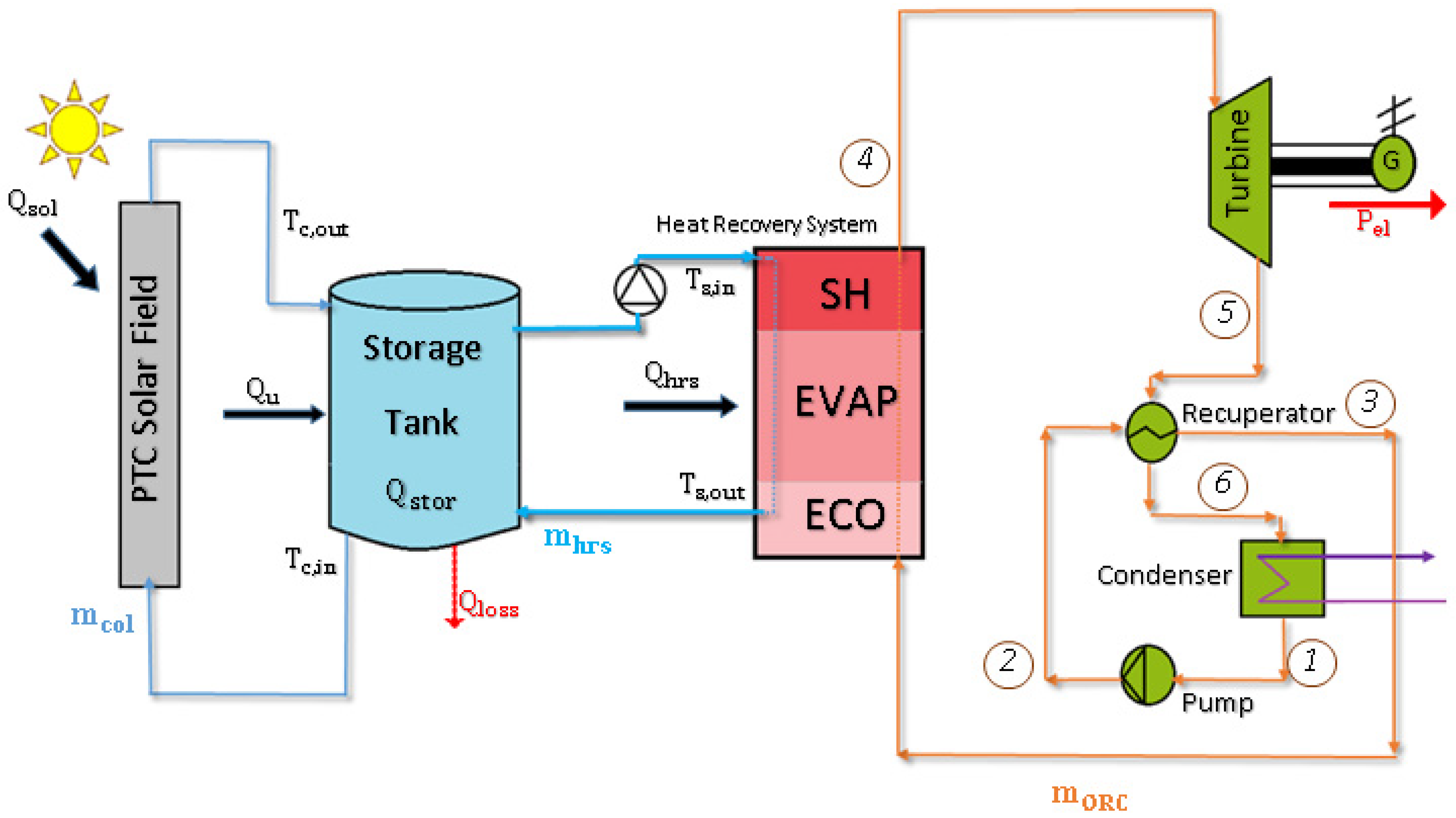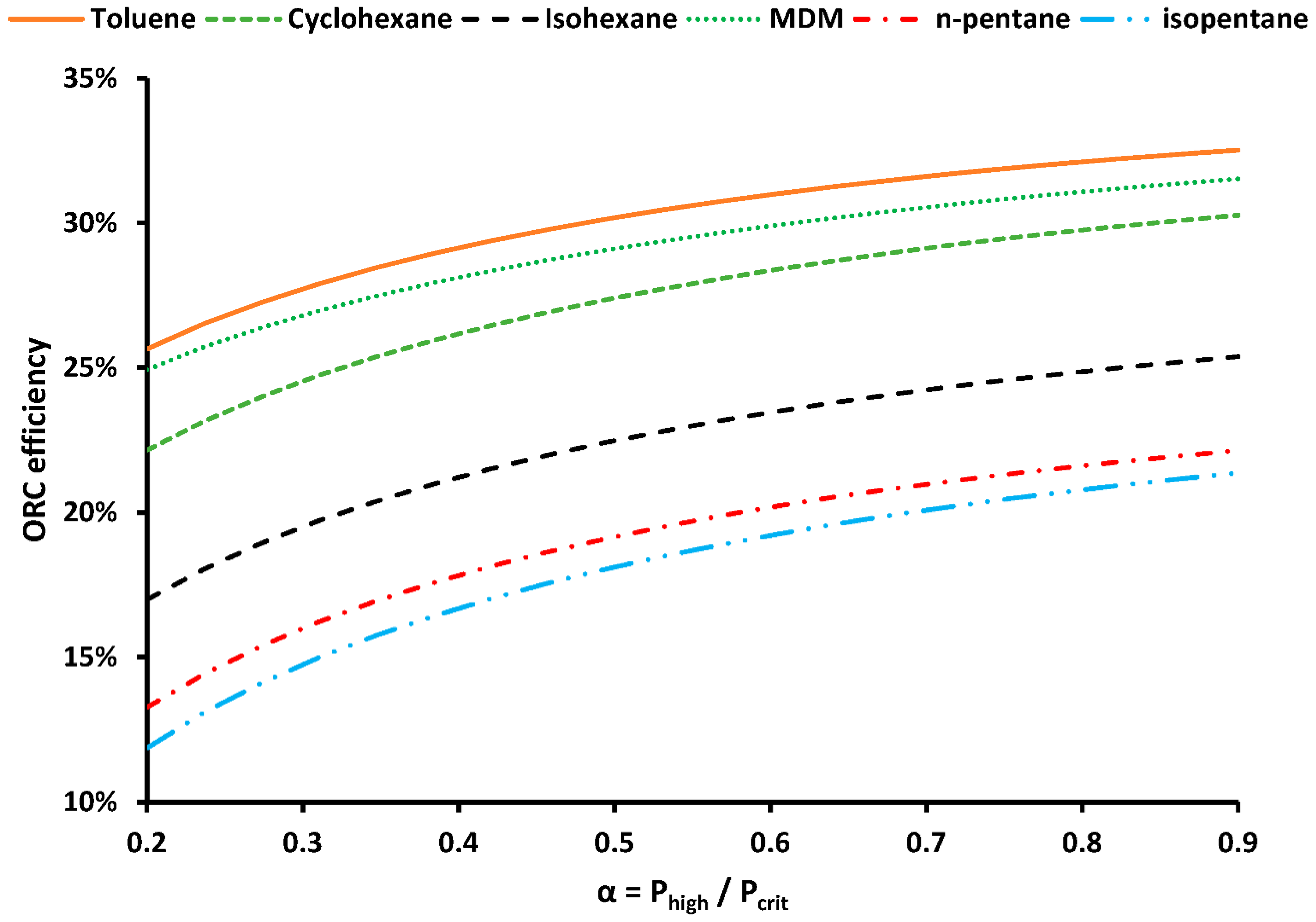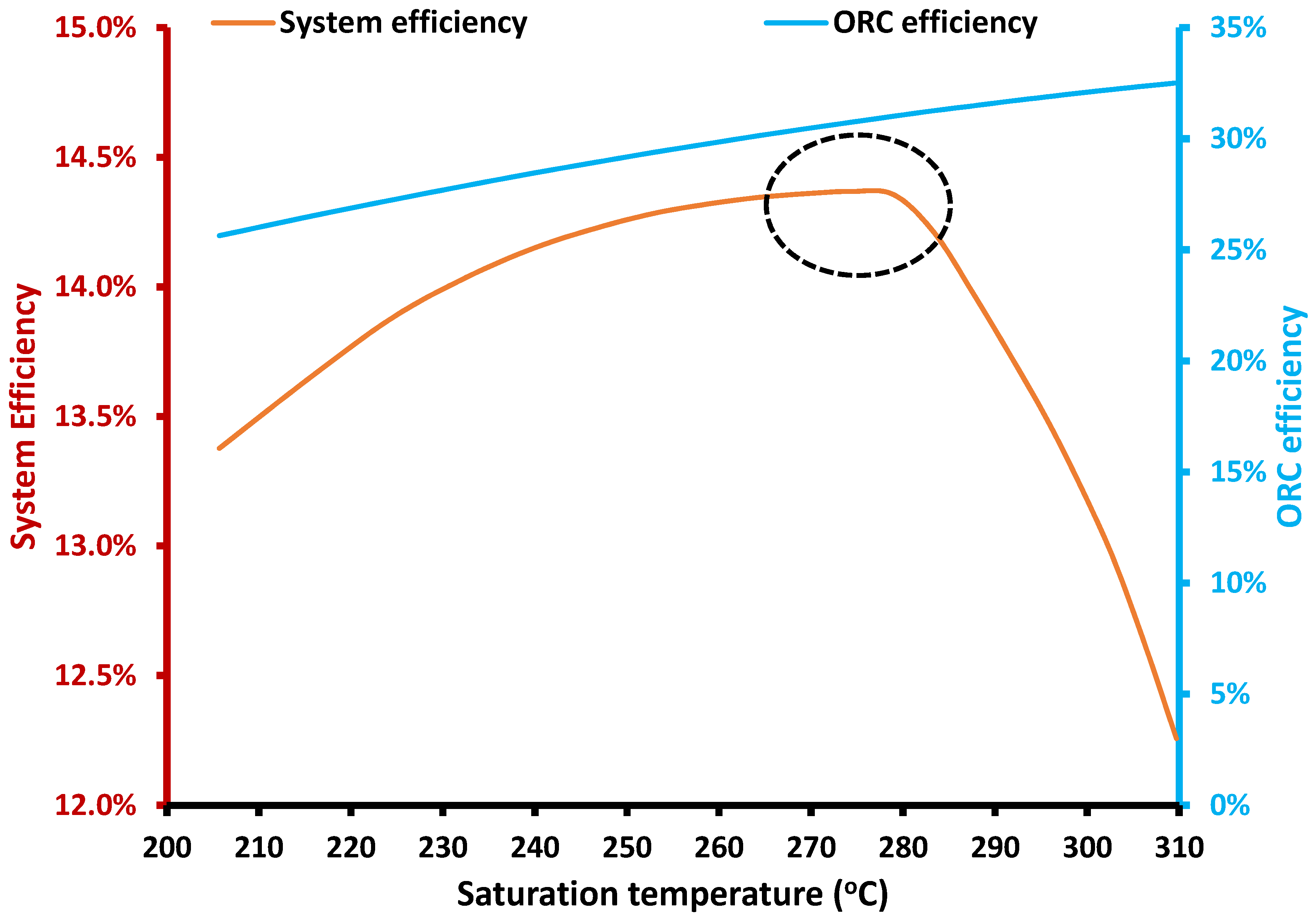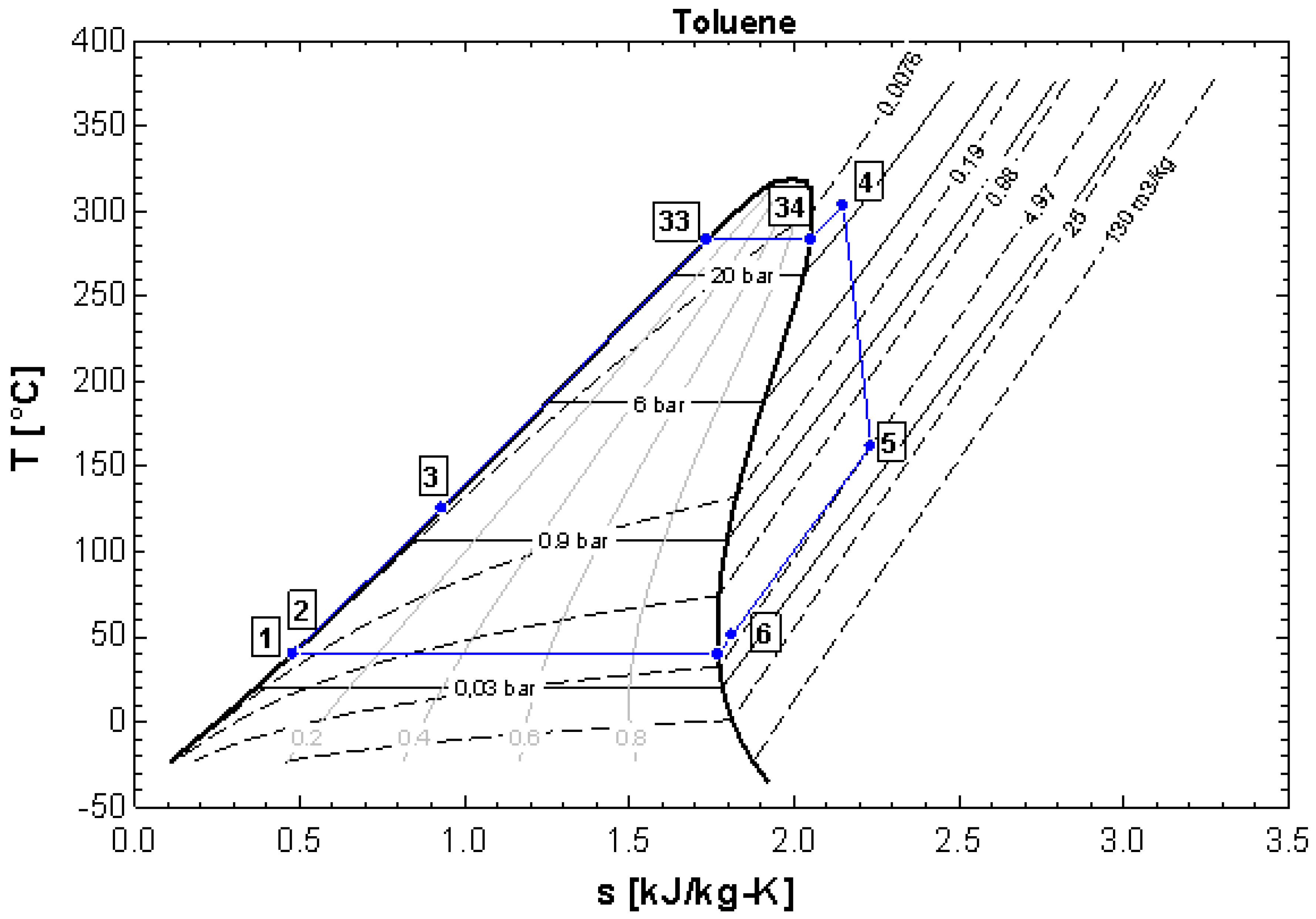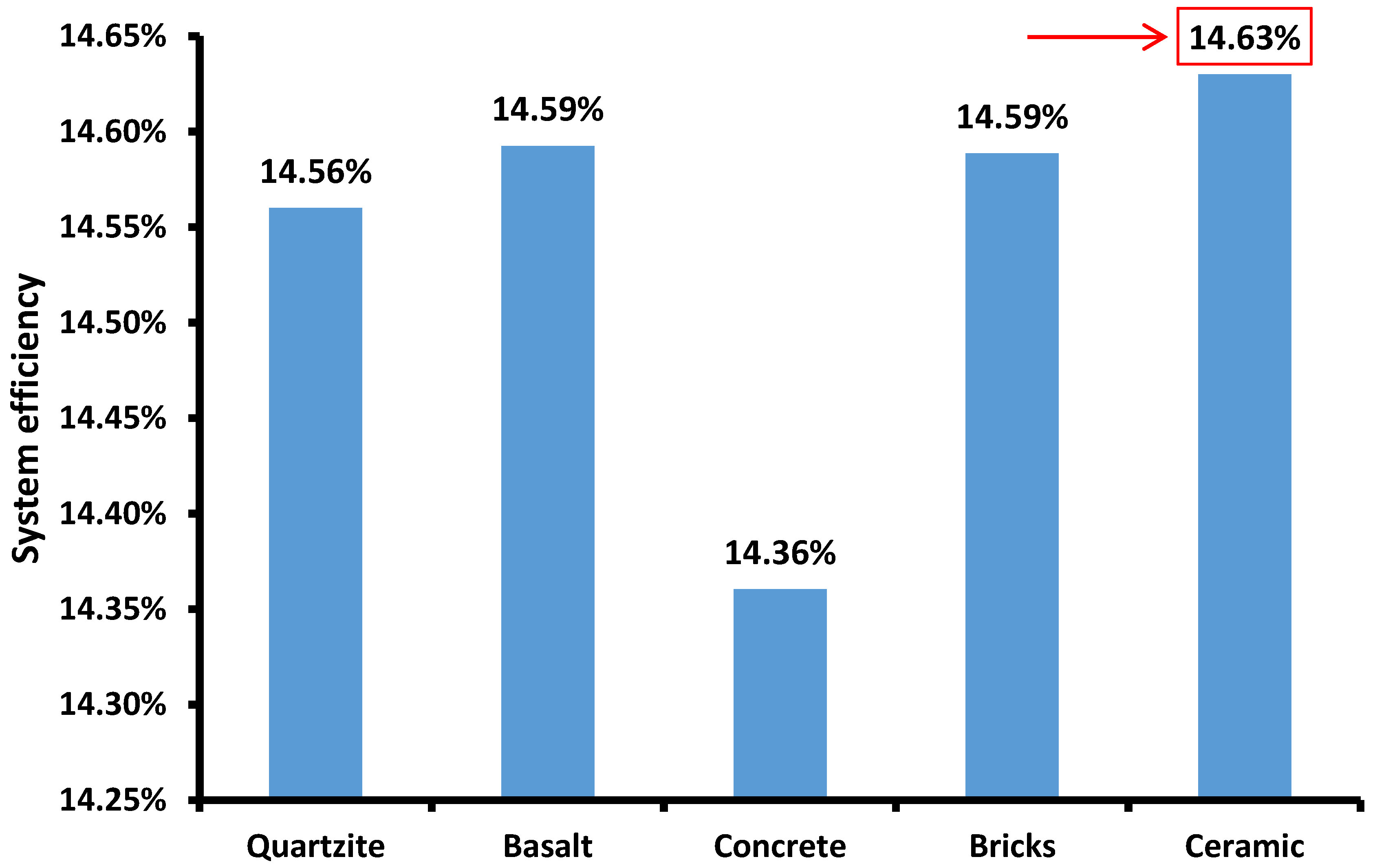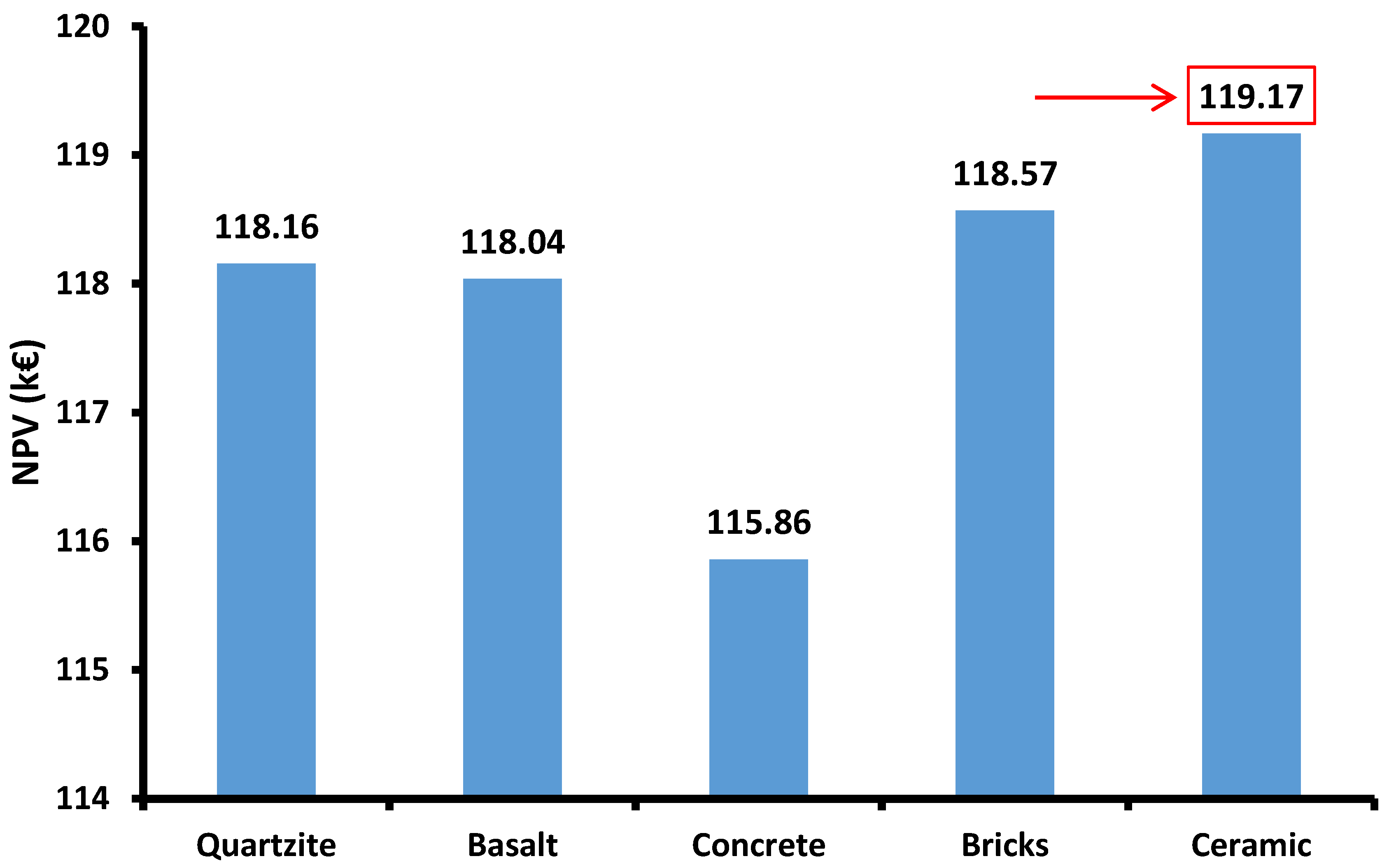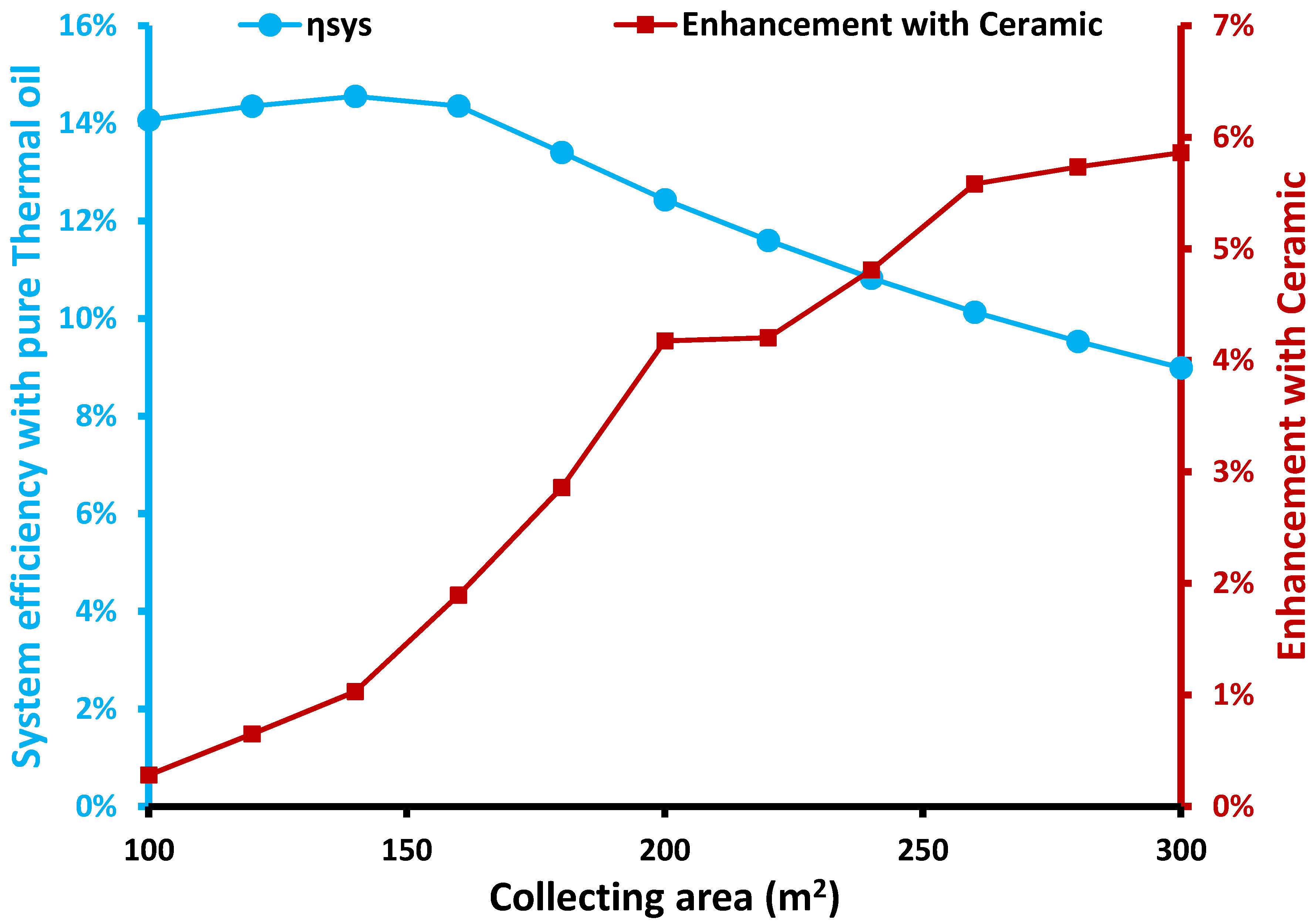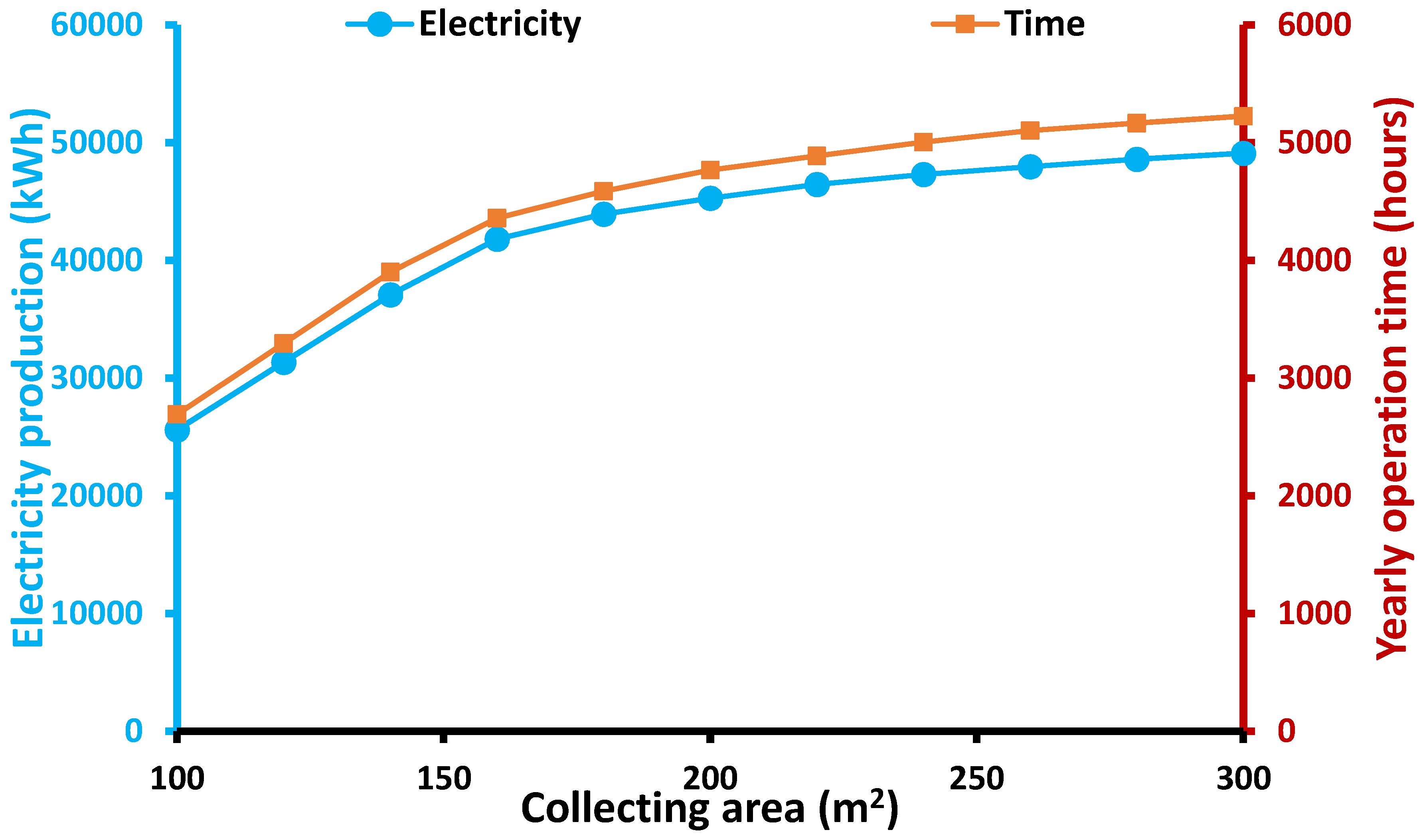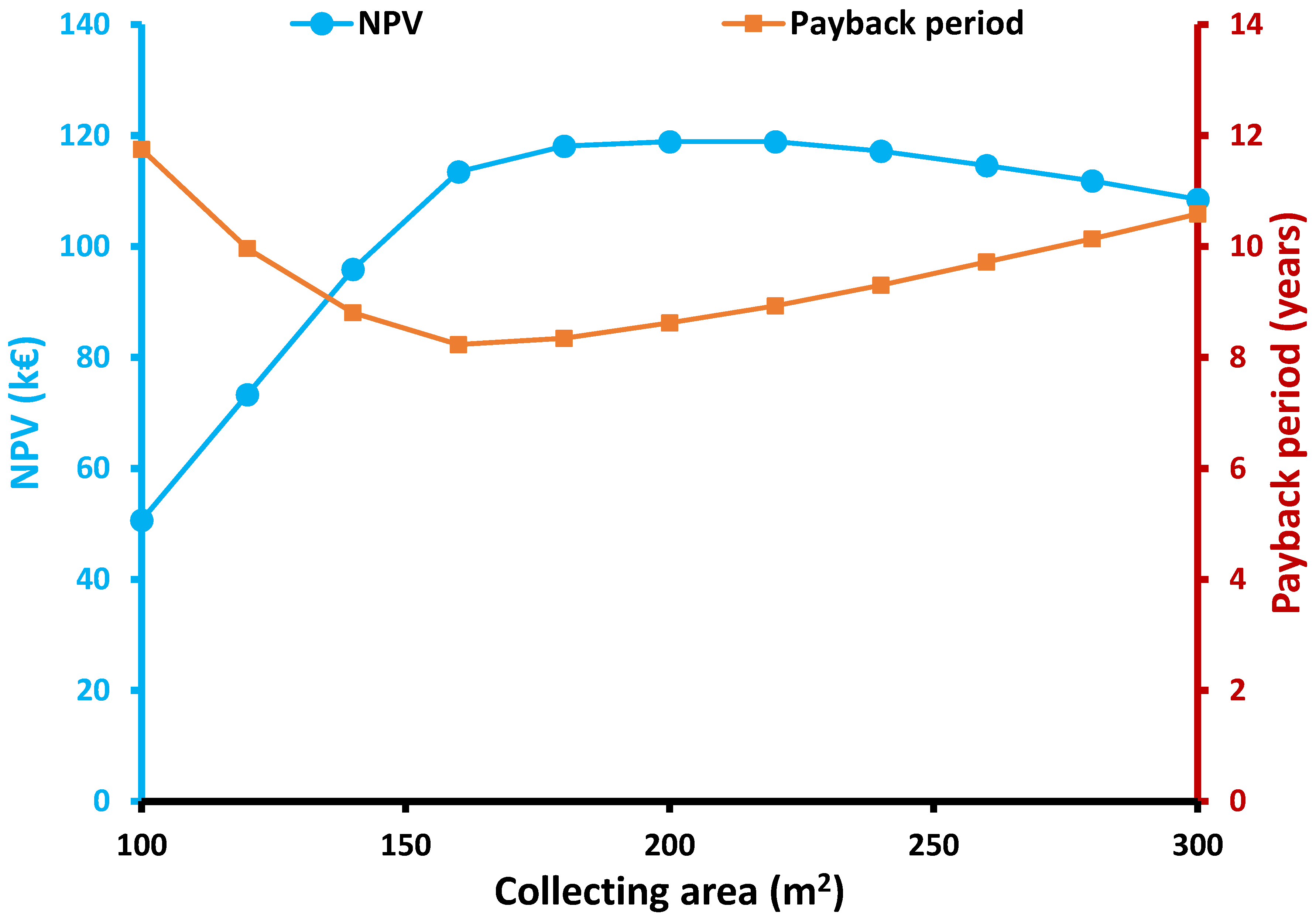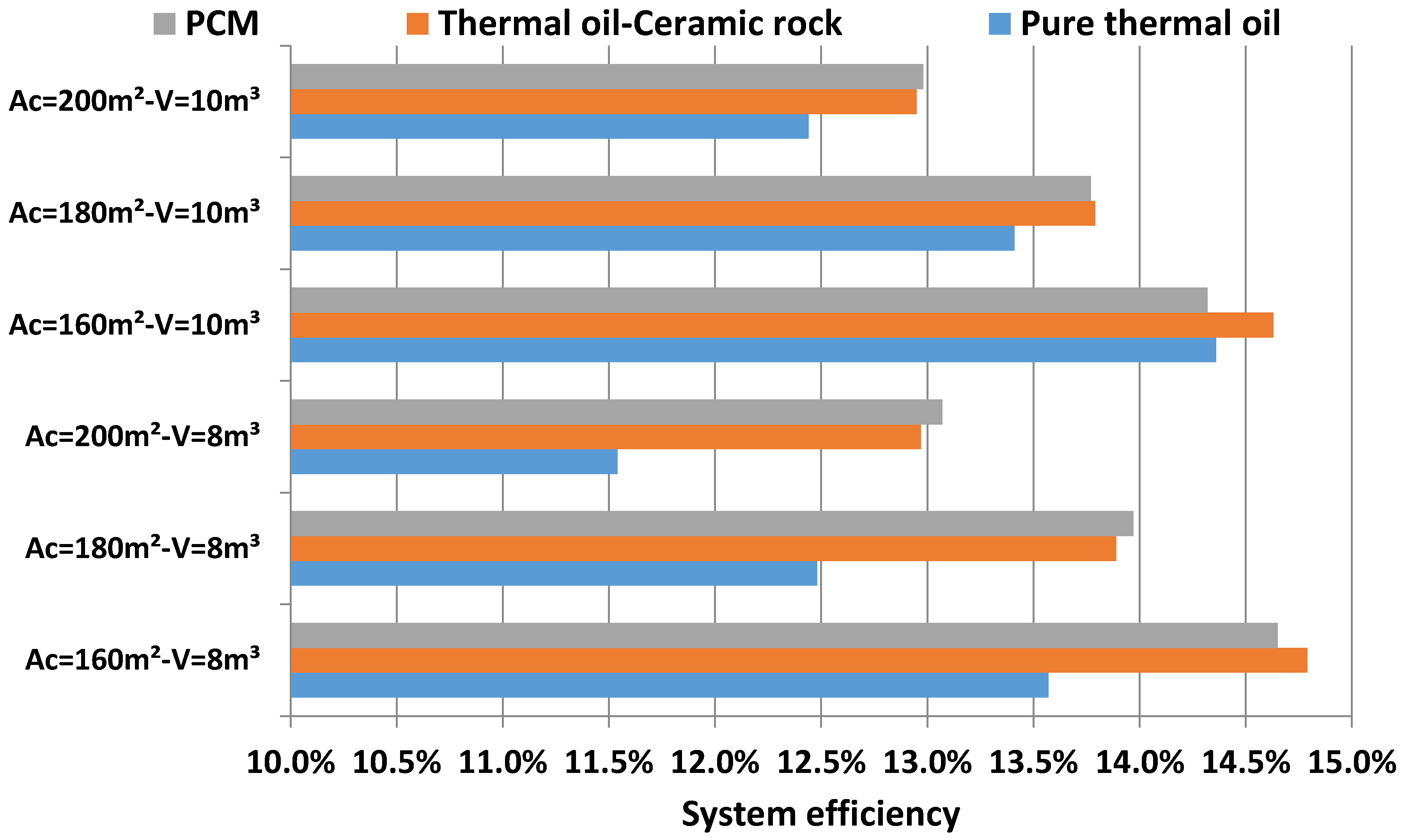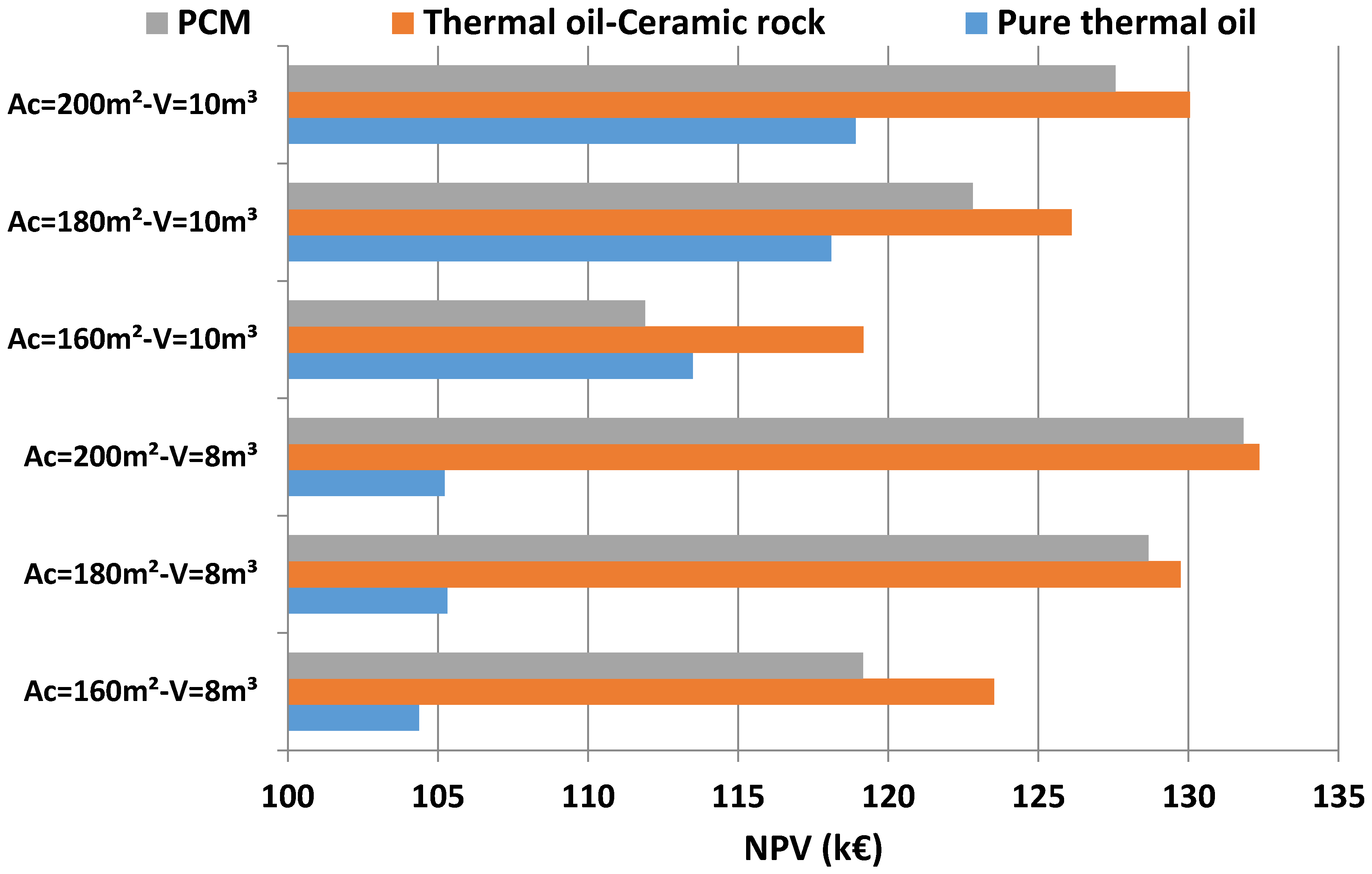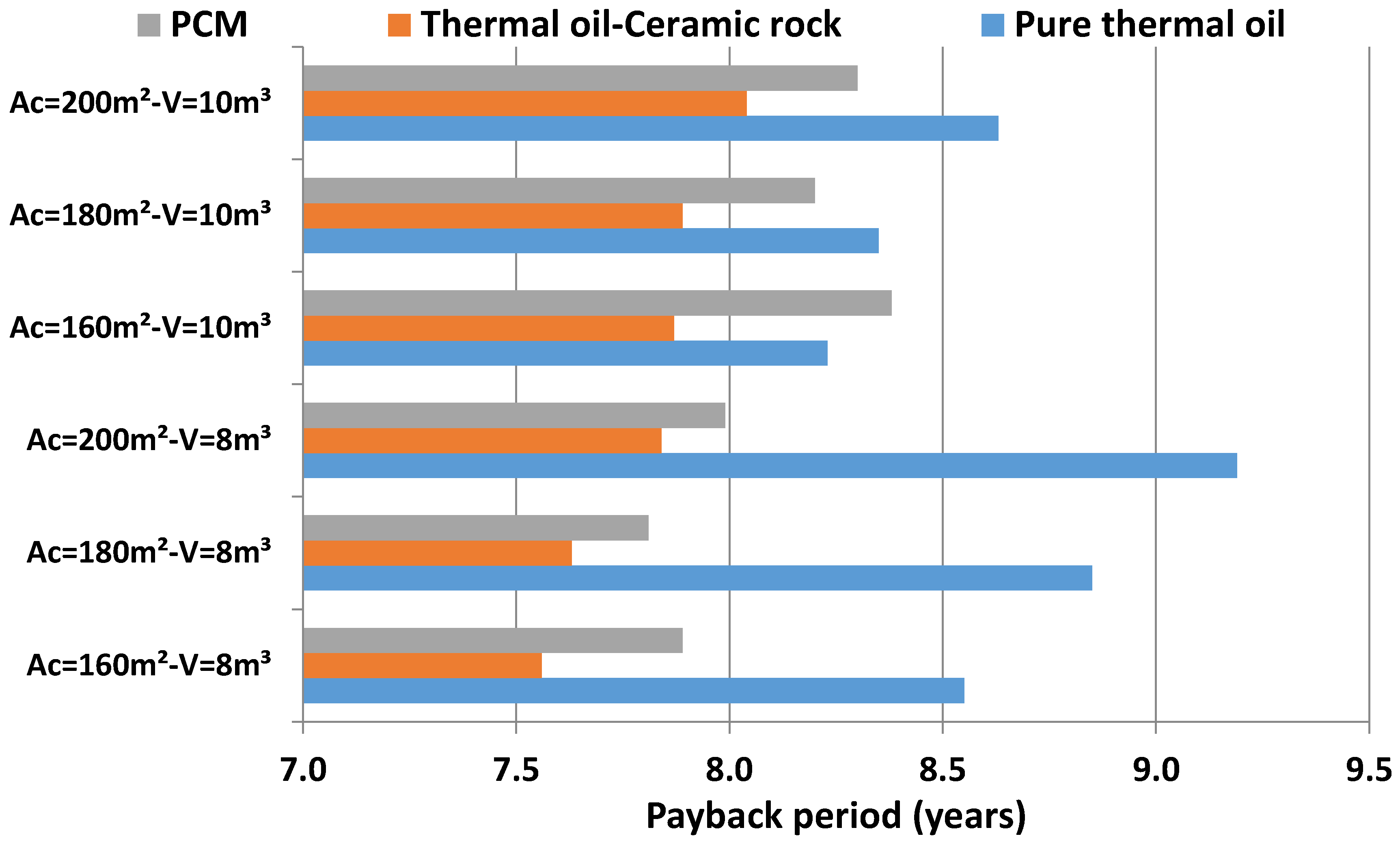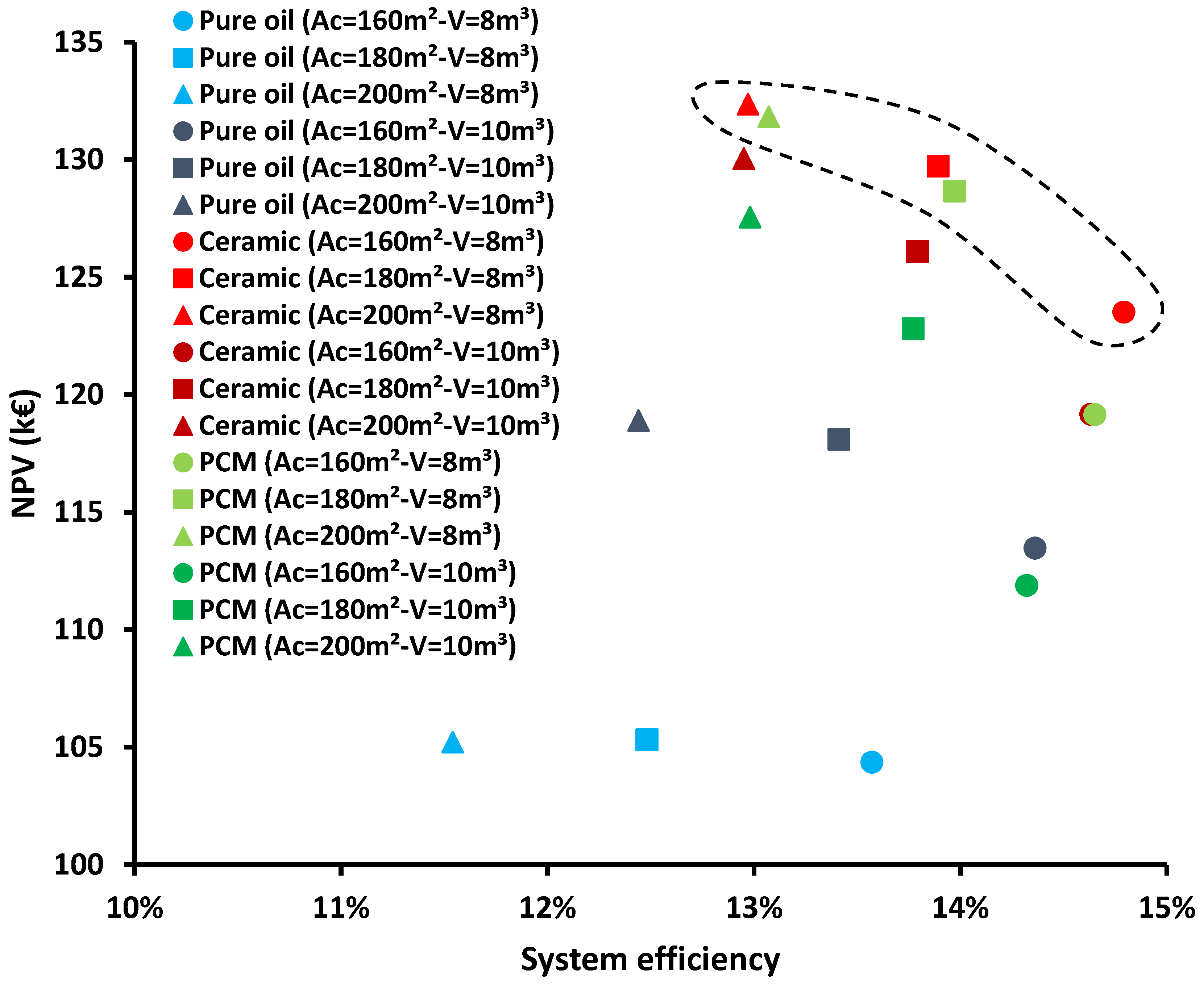3.2. Parametric Investigations of the Storage with Pure Thermal Oil and with Thermal Oil–Rocks
Firstly, the storage system with thermal oil-rocks is studied in this section. For the optimized system with toluene, different rocks were examined for the configuration with a collecting area at 160 m
2 and storage tank volume at 10 m
3. In all the examined rocks, the void fraction was 40%.
Figure 6 shows that the highest system efficiency was found for ceramic material with 14.63%, while basalt and bricks were the next candidates with 14.59%, quartzite with 14.56%, and concrete with 14.36%. So, energetically the ceramic rocks were the best materials for the storage system.
Figure 7 illustrates the NPV of these cases. The ceramic material led to 119.17 k€, the bricks to 118.57 k€, the quartzite to 118.16 k€, the basalt to 118.04 k€ and to 115.86 k€. So, the financial analysis indicated that the ceramic rocks led to the maximum NPV. The financial and economic results made clear that the ceramic rocks have to be selected as the most appropriate candidate.
The next part regarded a parametric analysis for different collecting areas and storage tank volume at 10 m
3 with pure thermal oil.
Figure 8 shows that the optimum system efficiency was close to 140–160 m
2. High collecting areas reduced the ability of the system to exploit efficiently all the useful heat product because the electricity production was set at 10 kW. Moreover, the low values of the collecting area made the system not able to reach easily the proper temperature limits in order to start the ORC operation, and so the efficiency was not maximized in the smallest examined collecting areas. Moreover,
Figure 8 shows that the system with thermal oil–ceramic rocks presented higher system efficiency than the respective cases of the pure thermal oil for all the collecting areas. The efficiency enhancement was higher in higher collecting areas and it ranged from 0.28% at 100 m
2 to 5.86% at 300 m
2.
Figure 9 exhibits the electricity product for different collecting areas with pure thermal oil. It is clear that a higher collecting area led to greater electricity yield, but the increasing rate had a reducing trend. This fact was justified by the reduction in the system efficiency after the 160 m
2. Moreover, the yearly operating time is depicted in the same figure and its curve has the same trend as electricity production. The yearly operating time ranged from 2693 h up to 5226 h, which meant that the system operating capacity also ranged from 30.7% up to 59.7%.
Lastly,
Figure 10 shows the NPV and the payback period for different collecting areas. The NPV I maximized in the range of 180 to 220 m
2, while the payback period was minimized close to 160 m
2. The maximum NPV was about 120 k€, while the minimum payback period was about eight years.
3.3. Final Comparison of the Three Examined Storage Systems
The last part of the results section is devoted to the direct comparison of the three examined storage systems. The previous results in
Section 3.1 and
Section 3.2 were important in order to select the proper organic fluid, the proper rock material, and the proper ORC saturation temperature and to determine the most interesting collecting areas. According to the results of
Section 3.2, the collecting area has to be in the range of 160 to 200 m
2 in order to have both high system efficiency and high NPV. Two storage tank volumes were examined and they were 8 m
3 and 10 m
3. It has to be said that this volume was the total volume of the device, which included inside the tubing and all the stored materials.
Figure 11 shows the system efficiency for the six examined designs and the three different storage systems (total of 18 scenarios). It has to be said that in all the examined cases, the pure thermal oil case was less efficient than the PCM and the thermal oil–ceramic rock cases. The use of ceramic rocks was found to be the best of the three cases and the PCM for the other three cases, so it is obvious that both these techniques can enhance efficiently the system performance compared to the operation with pure thermal oil storage. The maximum system efficiency was found for the designs with 160 m
2 (with 8 or 10 m
3) and in these cases, the thermal oil–ceramic rock was the best design. The global maximum system efficiency was found to be 14.79% for the cases [
Ac = 160 m
2 −
V = 8 m
3], while the case with the PCM was 14.65% and with pure thermal oil was 13.57%.
Figure 12,
Figure 13 and
Figure 14 present the financial indexes of the examined system for all the scenarios.
Figure 12 shows the results of the NPV,
Figure 13 the payback period, and
Figure 14 the LCOE.
Figure 12 indicates that the overall maximum NPV was found for [
Ac = 200 m
2 −
V = 8 m
3] with thermal oil–ceramic rocks and it was 132.36 k€. It is important to state that the pure thermal oil led to the minimum NPV in all the cases, and thus it was not a financially attractive choice.
Figure 13 indicates that the overall minimum payback period was found for [
Ac = 160 m
2 −
V = 8 m
3] with thermal oil–ceramic rocks, and it was 7.56 years. Moreover,
Figure 13 indicates that the overall minimum LCOE was found for [
Ac = 160 m
2 −
V = 8 m
3] with thermal oil–ceramic rocks and it was 0.0891 EUR/kWh.
Table 5,
Table 6 and
Table 7 include the aforementioned data in order to be clear.
Table 5 includes results for the case of pure thermal oil,
Table 6 for the case of thermal oil–ceramic rocks, and
Table 7 for PCM.
The previous analysis proved that only the single-optimization criteria indicated the use of the thermal oil–ceramic rock as the most suitable design, while the use of the pure thermal oil was the less efficient choice. However, it is important to state that the optimum designs (
Ac, V) were different among the examined criteria, and so there was not a global maximum choice that was the best one with all the criteria. Therefore, there was a need to conduct a more detailed analysis with a multi-objective depiction of energy and financial criteria together. The system efficiency and the NPV were selected to be used in a two-dimensional depiction, which is given in
Figure 15. The goal was to determine the choices that maximized both these criteria. So, a Pareto front was created with five design points: three points with thermal oil–ceramic rock and two points with PCM.
Table 8 summarizes the optimum points of the Pareto front and also includes the symbols of these cases that correspond to the depiction of
Figure 15. It can be said that every point in the Pareto front had a better index than the others; so there was not any point among them that had the same two indexes as the other point. So, all these five designs were optimum and the selection of one of them was based on extra criteria, such as the availability and the long-term reliability of every technology. It can be said that the use of ceramic rocks presented more optimum points in the Pareto front, and also it was the best design according to the single-criterion, and therefore it seemed to have precedence in the final selection. Generally, the results were better for the cases with 8 m
3, and thus these results are explained in detail below.
For the design with the 160 m2 collecting area and 8 m3 storage tank volume, the thermal oil–ceramic rocks design led to 14.79% system efficiency and net present value to 123.52 k€, the phase change material storage to 14.65% and 119.16 k€, respectively, while the pure thermal oil case led to 13.57% and 104.37 k€, respectively. So, in this case, the electricity production enhancement with ceramic rocks compared to the pure thermal oil was 8.99%, while the enhancement with PCM compared to the pure oil was 7.95%.
For the design with a 180 m2 collecting area and 8 m3 storage tank volume, the thermal oil–ceramic rocks design led to 13.89% system efficiency and net present value to 129.73 k€, the phase change material storage to 13.97% and 128.66 k€, respectively, while the pure thermal oil case led to 12.48% and 105.32 k€, respectively. So, in this case, the electricity production enhancement with ceramic rocks compared to the pure thermal oil was 11.3%, while the enhancement with PCM compared to the pure oil was 11.9%.
For the design with a 200 m2 collecting area and 8 m3 storage tank volume, the thermal oil–ceramic rocks design led to 12.97% system efficiency and net present value to 132.36 k€, the phase change material storage to 13.07% and 131.83 k€, respectively, while the pure thermal oil case led to 11.54% and 118.91, k€ respectively. In this case, the electricity production enhancement with ceramic rocks compared to the pure thermal oil was 12.4%, while the enhancement with PCM compared to the pure oil was 13.3%.
Furthermore, it is important to note that when the collecting area was varied from 160 m2 to 200 m2 with the tank volume at 8 m3, the efficiency enhancement with ceramic rocks compared to pure oil ranged from 8.99% up to 12.39%, while the enhancement with PCM ranged from 7.96% to 13.26%. For the same conditions, the NPV was improved with ceramic rocks from 18.35% to 25.79%, while with PCM from 14.17% to 25.29%.
About the payback period, for the case [Ac = 160 m2 − V = 8 m3] it was 7.56 years for ceramics, 7.89 for PCM, and 8.55 for pure oil; for the case [Ac = 180 m2 − V = 8 m3] it was 7.63 years for ceramics, 7.81 for PCM, and 8.85 for pure oil; and for the case [Ac = 200 m2 − V = 8 m3] it was 7.84 years for ceramics, 7.99 for PCM, and 9.19 for pure oil.
Finally, it can be said that the use of PCM can enhance more electricity production than the use of ceramics, but the use of ceramics is more beneficial financially, according to all the criteria. Generally, both PCM and ceramic rocks have similar behavior, and they are clearly better choices than the use of pure thermal oil. Another point that has to be stated regards the relatively small differences between the efficiency and the financial parameter values. These small differences indicated the trends among the examined cases, and they were able to show the most effective techniques in every case.
Comparing the found results with others from the literature, it can be said that the found results accorded with other studies. For example, the use of rocks inside the tank was found to lead to a 30% improvement in the financial indicators of the system, according to Rodriguez et al. [
14]. The present work found around a 25% improvement, which is a similar result. Moreover, the studies [
18,
19] found performance enhancement at 18% and 20%, while this work indicated 13%. The other studies [
18,
19] had a bit higher enhancement because they regarded small-scale systems where there were higher enhancement margins due to the non-optimized design. On the other hand, the baseline case of this work was an already optimized scenario so the 13% enhancement (maximum value) was an acceptable and promising one.
